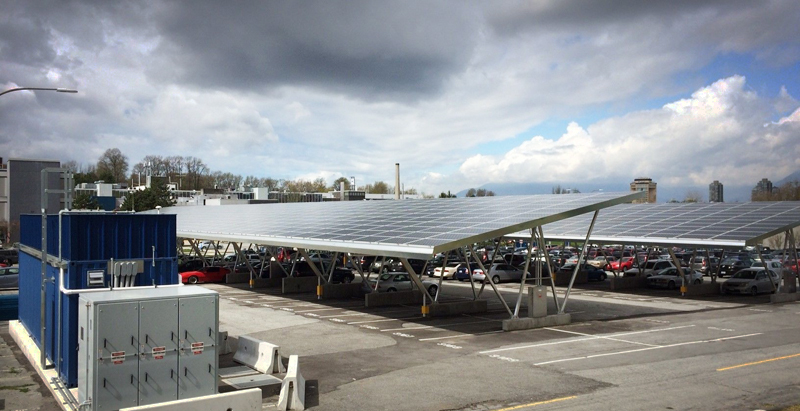Setting the Scene for Innovative Eco Solutions
Located on the scenic west coast of Canada, the British Columbia Institute of Technology (BCIT) is a public polytechnic institution of higher education. Its five campuses sprawl across the Metro Vancouver region with the main campus located in Burnaby, British Columbia.
A forward thinking institution that believes in a hands-on approach to learning, BCIT wanted to develop a renewable energy system that would have a real impact on clean transportation and incorporate innovative solar components.
The Roots of Success
It all began in early 2007, when BC Hydro, a Canadian electric utility, and SMART, a BCIT Applied Research Group, embarked on a joint research initiative to design and develop Canada's first Smart Power Microgrid at BCIT's Burnaby campus. The goal was to build a smarter, more secure power grid that would balance power generation to demand, reduce the potential for blackouts, and integrate current energy sources.
Titled the Smart Microgrid Program, the ongoing initiative includes BCIT’s Energy OASIS (Open Access to Sustainable Intermittent Sources) project involving a network of fast and standard charging stations that allow electric cars to be charged in minutes – facilitating the transition to green transportation in Canada.
Making it Happen
To make the Energy Oasis a reality, Panasonic Eco Solutions Canada was chosen to design and construct the integrated system of parking canopy structures, canopy mounted solar panels, and energy storage system.
Panasonic got to work engineering, procuring, and constructing the two parking canopies with 250 kW of solar PV – enough to power the EV charging stations. The team also designed and installed a 500 kWh energy storage and energy management system utilizing Panasonic lithium-ion batteries and a bidirectional inverter. The Panasonic Battery Energy Storage System (BESS) communicates with a Distributed Energy Management System, which learns when to buy, sell or store energy using intelligent algorithms and sends the requests to store or discharge the BESS at key times, such as peak usage or in low utility rate hours.
Collaborating with BCIT and other industry partners, Panasonic integrated the solar and battery systems into BCIT’s microgrid for a comprehensive, innovative structure.
Lasting Achievement
Recognized with a Canadian Solar Industries Association (CanSIA) Game Changer Award, the project was the first of its kind in Canada to successfully demonstrate the integration of solar power, energy storage, and electric vehicle charging stations in a grid-tied or ‘islanded’ configuration. With the team’s commissioning and post implementation support services, BCIT can count on reliable startup and continuous operation for years to come.
To learn more about Panasonic Eco Solutions and our work in North America, please visit www.panasonic.com/energysolutions.
Related Stories
| Jul 18, 2014
Contractors warm up to new technologies, invent new management schemes [2014 Giants 300 Report]
“UAV.” “LATISTA.” “CMST.” If BD+C Giants 300 contractors have anything to say about it, these new terms may someday be as well known as “BIM” or “LEED.” Here’s a sampling of what Giant GCs and CMs are doing by way of technological and managerial innovation.
| Jul 18, 2014
Top Construction Management Firms [2014 Giants 300 Report]
Jacobs, Barton Malow, Hill International top Building Design+Construction's 2014 ranking of the largest construction management and project management firms in the United States.
| Jul 18, 2014
Top Contractors [2014 Giants 300 Report]
Turner, Whiting-Turner, Skanska top Building Design+Construction's 2014 ranking of the largest contractors in the United States.
| Jul 18, 2014
Engineering firms look to bolster growth through new services, technology [2014 Giants 300 Report]
Following solid revenue growth in 2013, the majority of U.S.-based engineering and engineering/architecture firms expect more of the same this year, according to BD+C’s 2014 Giants 300 report.
| Jul 18, 2014
Top Engineering/Architecture Firms [2014 Giants 300 Report]
Jacobs, AECOM, Parsons Brinckerhoff top Building Design+Construction's 2014 ranking of the largest engineering/architecture firms in the United States.
| Jul 18, 2014
Top Engineering Firms [2014 Giants 300 Report]
Fluor, Arup, Day & Zimmermann top Building Design+Construction's 2014 ranking of the largest engineering firms in the United States.
| Jul 18, 2014
Top Architecture Firms [2014 Giants 300 Report]
Gensler, Perkins+Will, NBBJ top Building Design+Construction's 2014 ranking of the largest architecture firms in the United States.
| Jul 18, 2014
2014 Giants 300 Report
Building Design+Construction magazine's annual ranking the nation's largest architecture, engineering, and construction firms in the U.S.
| Jul 9, 2014
First Look: SOM's design for All Aboard Florida Fort Lauderdale rail station
The lightweight and luminous design "responds to its setting and creates a striking infrastructural icon for the city," said SOM Design Partner Roger Duffy.
| Jul 7, 2014
7 emerging design trends in brick buildings
From wild architectural shapes to unique color blends and pattern arrangements, these projects demonstrate the design possibilities of brick.

















